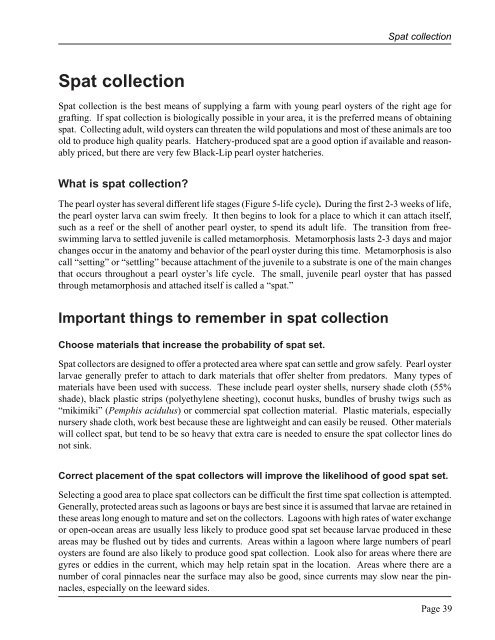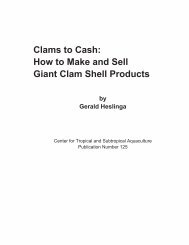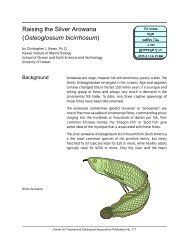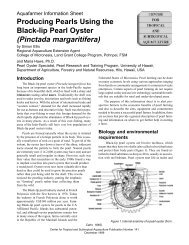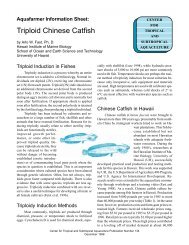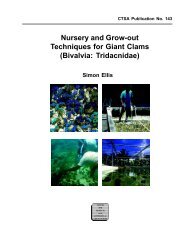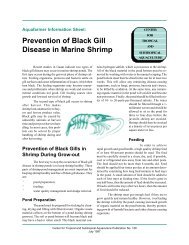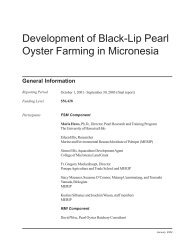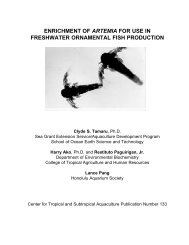The Basic Methods of Pearl Farming: A Layman's Manual - CTSA
The Basic Methods of Pearl Farming: A Layman's Manual - CTSA
The Basic Methods of Pearl Farming: A Layman's Manual - CTSA
You also want an ePaper? Increase the reach of your titles
YUMPU automatically turns print PDFs into web optimized ePapers that Google loves.
Spat collectionSpat collectionSpat collection is the best means <strong>of</strong> supplying a farm with young pearl oysters <strong>of</strong> the right age forgrafting. If spat collection is biologically possible in your area, it is the preferred means <strong>of</strong> obtainingspat. Collecting adult, wild oysters can threaten the wild populations and most <strong>of</strong> these animals are tooold to produce high quality pearls. Hatchery-produced spat are a good option if available and reasonablypriced, but there are very few Black-Lip pearl oyster hatcheries.What is spat collection?<strong>The</strong> pearl oyster has several different life stages (Figure 5-life cycle). During the first 2-3 weeks <strong>of</strong> life,the pearl oyster larva can swim freely. It then begins to look for a place to which it can attach itself,such as a reef or the shell <strong>of</strong> another pearl oyster, to spend its adult life. <strong>The</strong> transition from freeswimminglarva to settled juvenile is called metamorphosis. Metamorphosis lasts 2-3 days and majorchanges occur in the anatomy and behavior <strong>of</strong> the pearl oyster during this time. Metamorphosis is alsocall “setting” or “settling” because attachment <strong>of</strong> the juvenile to a substrate is one <strong>of</strong> the main changesthat occurs throughout a pearl oyster’s life cycle. <strong>The</strong> small, juvenile pearl oyster that has passedthrough metamorphosis and attached itself is called a “spat.”Important things to remember in spat collectionChoose materials that increase the probability <strong>of</strong> spat set.Spat collectors are designed to <strong>of</strong>fer a protected area where spat can settle and grow safely. <strong>Pearl</strong> oysterlarvae generally prefer to attach to dark materials that <strong>of</strong>fer shelter from predators. Many types <strong>of</strong>materials have been used with success. <strong>The</strong>se include pearl oyster shells, nursery shade cloth (55%shade), black plastic strips (polyethylene sheeting), coconut husks, bundles <strong>of</strong> brushy twigs such as“mikimiki” (Pemphis acidulus) or commercial spat collection material. Plastic materials, especiallynursery shade cloth, work best because these are lightweight and can easily be reused. Other materialswill collect spat, but tend to be so heavy that extra care is needed to ensure the spat collector lines donot sink.Correct placement <strong>of</strong> the spat collectors will improve the likelihood <strong>of</strong> good spat set.Selecting a good area to place spat collectors can be difficult the first time spat collection is attempted.Generally, protected areas such as lagoons or bays are best since it is assumed that larvae are retained inthese areas long enough to mature and set on the collectors. Lagoons with high rates <strong>of</strong> water exchangeor open-ocean areas are usually less likely to produce good spat set because larvae produced in theseareas may be flushed out by tides and currents. Areas within a lagoon where large numbers <strong>of</strong> pearloysters are found are also likely to produce good spat collection. Look also for areas where there aregyres or eddies in the current, which may help retain spat in the location. Areas where there are anumber <strong>of</strong> coral pinnacles near the surface may also be good, since currents may slow near the pinnacles,especially on the leeward sides.Page 39


